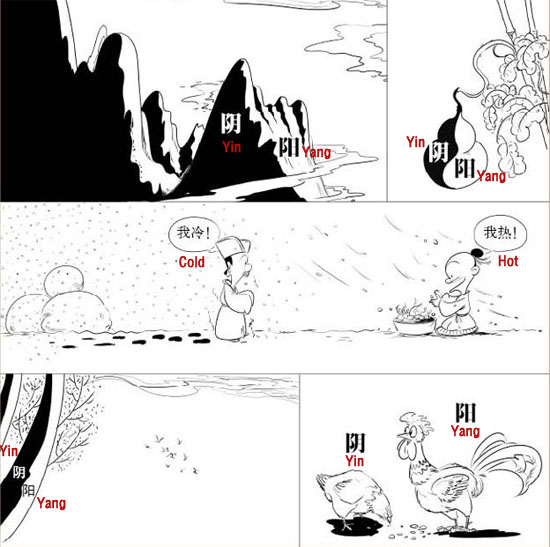The yin and yang aspects within an object or phenomenon are not simply arbitrary divisions. In fact they are in constant and complicated interaction. Such interactions between yin and yang give rise to the origination, development and change of things. The interactions between yin and yang are various in manifestations. The following is a brief description of the major ones.
Opposition of Yin and yang
Since yin and yang are opposite to each other in nature, they constantly repel and restrain each other. If both yin and yang are quite powerful, such a mutual repelling and restraining activity will maintain general equilibrium of things. If one side is weak and the other side is strong, the strong side will restrain the weak side, consequently damaging the general balance of things. The so-called "contrary treatment", one of the basic therapeutic principles in TCM, is developed in the light of the opposition between yin and yang.
For example, the treatment of cold disease with drugs hot in nature means to use heat (yang) to control cold (yin) while the treatment of febrile disease with drugs cold in nature means to use cold drugs (yin) to restrict heat (yang). Since the drugs used and the disease treated are different in nature, such a treatment is termed "contrary treatment". "Contrary" means "opposite".
Interdependence Between Yin and Yang
Interdependence between yin and yang, literarily yin and yang rooting in each other, indicates that yin and yang depend on each other for existence in an object. In conception, yin and yang must exist in pair and no side can exist solitarily. In nature, yin and yang within an object can transform into each other under certain condition, implying that no one can exist without the existence of the other. That is why it is said in the theory of TCM that "solitary yang cannot exist" and "solitary yin cannot grow".

In the light of interdependence between yin and yang, TCM pays much attention to mutual transformation between qi and blood as well as yin and yang in the treatment of diseases due to deficiency of qi and blood as well as of yin and yang. For example, the patients with blood deficiency can be treated by supplementing qi to produce blood, the patients with qi deficiency can be treated by supplementing blood to promote qi, the patients with yin deficiency can be treated by supplementing yang to generate yin (also called "drawing yin from yang") and the patients with yang deficiency can be treated by supplementing yin to promote yang (also called "drawing yang from yin").
Wane and Wax Between Yin and Yang
Wane and wax between yin and yang implies that, in between yin and yang, one side is develop the other side is declining and vice versa. Such a state manifests in different ways, such as yin waning waxing, yin waxing while yang waning, yang to Yin waxing, and yang waxing leading to yin waning.
Under normal condition, wane and wax between yin and yang are maintained to a certain range. Waning to a certain degree will turn to waxing and waxing to a certain level will change into waning. In this way wane and wax will never be excessive.
Alternation and repetition of wane and wax maintain a dynamic balance between yin and yang. If wane and wax between yin and yang exceeds the normal level, relative predominance or .relative decline of either yin or yang will arise, consequently damaging the dynamic balance between yin and yang and leading to imbalance of yin and yang.
Mutual Transformation Between Yin and yang
If yin or yang wanes or waxes to the extreme point, it will turn to the opposite. That means yin will change into yang and yang into yin. The key element involved in such a mutual transformation is the degree of wane and wax. The degree that leads to transformation is termed "extreme point" or "excess" in TCM. In Huangdi Neijing, it suggests that "extreme cold generates heat", "extreme heat generates cold", "excessive yin turns into yang" and "excessive yang changes into yin", all reflecting mutual transformation relationship between yin and yang.
The typical mutual transformation process of yin and yang is well signified by the variations of yin and yang in the four seasons of a year. From spring to summer, yang waxes while yin wanes. However when such a transformation reaches the peak -- the Summer Solstice, yin begins to wax while yang starts to wane. From autumn to winter, yin waxes while yang wanes.
But when such a transformation reaches the peak -- the Winter Solstice, yang begins to wax while yin starts to wane. Such a change exactly explains the idea that "excessive yin turns into yang" and "excessive yang changes into yin". With the wane and wax of yin and yang, cold and heat in the climate also alternate. Such an alternation vividly demonstrates the theory that "extreme cold generates heat" and "extreme heat generates cold".







